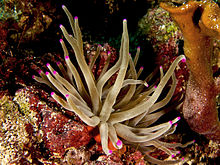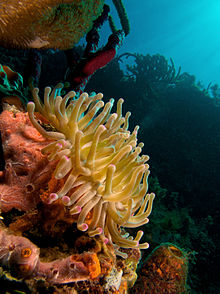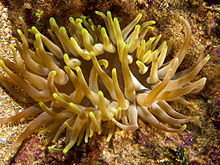- Condylactis gigantea
-
Condylactis gigantea 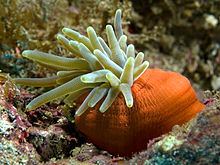
Wild specimen 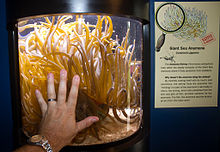
Size comparison with human hand Scientific classification Kingdom: Animalia Phylum: Cnidaria Class: Anthozoa Subclass: Hexacorallia Order: Actiniaria Suborder: Nyantheae Infraorder: Thenaria Family: Actiniidae Genus: Condylactis Species: C. gigantea Binomial name Condylactis gigantea
Weinland, 1860Condylactis gigantea is a tropical species of sea anemone that is found in coral reefs, shallow ocean waters, in shore areas in the Caribbean Sea – most specifically the West Indies – and the Western Atlantic Sea, ranging from southern Florida through the Florida Keys. It is also commonly known as : Giant Caribbean Sea Anemone, Giant Golden Anemone, Condylactis Anemone, Haitian anemone, Pink tipped anemone, Purple tipped anemone, and Florida Condy. This species can be easily seen growing in lagoons or on inner reefs as either individuals or loose groups, but never as colonies.
Contents
Habitat
Giant Caribbean Sea Anemone is usually found in the crevices of rock walls, attached to a rock, shell, or almost any other hard object in shallow water that experiences full–strength seawater most of the time, which may explain why the species is so common in Bermuda. Giant Caribbean Sea Anemone is also very common around reefs in both “forereef” and lagoon areas. It can also be found at most inshore areas, on coral reefs, though this is less common. Sea anemones in general can be found anywhere from the intertidal zone all the way to a depth of 30,000 feet.
Condylactis gigantea is an important member of their subtidal community by providing shelter to a variety of commensals (several fish and cleaner shrimp species) and they serve as a "base station" for fish cleaning activity.[1] [2]
Reproduction
The Giant Caribbean Sea Anemones' primary mating season is reported to be in late May, however they may continue to reproduce at a low levels throughout the year. This anemone is dioecious and hermaphroditic. It has a 1:1 to sex ratio (males to females) with no evidence of brooding or of asexual reproduction or division furrowing.
The Giant Caribbean Sea Anemones’ reproduction scheme is defined by Jennison (1981)[3] as oviparous → planktonic → lecithotrophic. The releasing or spawning of eggs and sperm are relatively synchronous with fertilization occurring externally in the water column. The success of fertilization depends upon the close proximity of separate sexed anemones. Fertilization produces a planula larva, which derives nutrients from yolk, thus larval death by starvation is unlikely, making dispersal an advantageous strategy to survival. The planula larva will settle on the benthos, develop a pedal disc, and then, eventually grow into a fully developed anemone.
Physical appearance
A Giant Caribbean Sea Anemone, is approximately 6” (15 centimeters) high and 12” (30 centimeters) wide, making the disc diameter approximately 16” (40 centimeters) in nature. It is a large, columnar animal and can exhibit a variety of colors: white, light blue, pink, organe, pale red, or light brown. Its mouth is surrounded by 100 or more tentacles. These tentacles differ in each individual of the species and their tips may be purple or rose colored or they even may not have any change in color, becoming paler than the body itself. The whole tentacles are shades of either brown or greenish and the basal disc is firmly attached to the substrate with the only "free–floating" portion being the tentacles.
Behavior
Although the Giant Caribbean Sea Anemone is primarily a sessile animal and has developed some mechanisms of defense and protection, it is actually quite a mobile species as far as anemones go, and the form of locomotion that it uses is crawling by way of its pedal disc. This movement of crawling is very slow and is not used in defense or in direct protection from predators. Giant Caribbean Sea Anemones instead reduce their size and draw their tentacles into their gastric cavity; their size is then reduced, and room is made in the gastric cavity by forcing most of the water out and, if their tentacles are not drawn into the gastric cavity, their volume is still reduced greatly. This approach to defense / protection allows for the surface area of these animals to be reduced enough to create less chance of a predator attacking it.
Giant Caribbean Sea Anemones have another more effective defense in their nematocysts, which are their stinging cells, tubular parts of cnidarian’s capsule–like cells.[4] The tips of the Giant Caribbean Sea Anemones’ tentacles are packed with nematocysts that contain a toxin. When stimulated, the nematocysts explode out of the capsule, impaling the attacker. The toxin is then discharged, causing extreme pain and paralysis.
A Giant Caribbean Sea Anemone is very aggressive towards other marine aquarium invertebrates, and it usually fights to conserve its own space on the ocean floor.
Diet
Giant Caribbean Sea Anemone is a macrophagous carnivore and feeds upon fish, mussels, shrimp, or any other similar organisms. It will not, however, go near any natural predators, such as Red Leg Hermits.
The anemone's nematocysts help it to capture food as well as defend against predators. All prey are quickly paralyzed by the toxin–bearing nematocysts located on the tentacles; then the prey is quickly carried to the mouth, which is opened by radial muscles in the mesentery, and the prey is eventually swallowed whole and digested extracellularly as well as intracellularly.
Effects on humans
Giant Caribbean Sea Anemones don’t have any major effect on humans, except that all of the studies done on the anemones are actually helpful in the pharmaceutical and medical industries.[clarification needed] By extracting proteins from the tissues, it is suggested that this anemone’s neurons contain neurofilament–like proteins that are molecularly similar to the neurons of mammals. This means that many studies can be done on the evolution of nervous systems by experimenting on present-day cnidarians such as the Giant Caribbean Sea Anemones.
References
- ^ Hanlon, R.T., Hixon, R.F. (1986) Behavioral associations of coral reef fishes with the sea anemone Condylactis gigantea in the Dry Tortugas, Florida. Bulletin of Marine Science 39(1):130-134.
- ^ Mahnken, C. (1972) Observations on cleaner shrimps of the Genus Periclemenes. Bulletin of Natural History Museum Los Angeles County 14:71-83.
- ^ Jennison, B.L. (1981) Reproduction in three species of sea anemones from Key West, Florida. Canadian Journal of Zoology, 59:1708-1719.
- ^ http://hercules.kgs.ku.edu/Hexacoral/Anemone2/cnidae_information.cfm?genus=Condylactis&subgenus=&species=gigantea&subspecies=&correctgenus=Condylactis&correctsubgenus=&correctspecies=gigantea&correctsubspecies=&validgenus=Condylactis&validspecies=gigantea&validsubgenus=&validsubspecies=&validname=Condylactis%20gigantea&authorship=%28Weinland%2C%201860%29
- http://www.fishlore.com/profile-condyanemone.htm
- http://www.thecephalopodpage.org/MarineInvertebrateZoology/Condylactisgigantea.html
- http://actiniaria.com/condylactis_gigantea.php
- http://animaldiversity.ummz.umich.edu/site/accounts/information/Condylactis_gigantea.html
- http://www.freshmarine.com/condylactis-anemone.html
- http://life.nbii.gov/dml/mediadetail.do?id=4837 (this link may have to be reloaded to work)
Categories:
Wikimedia Foundation. 2010.

